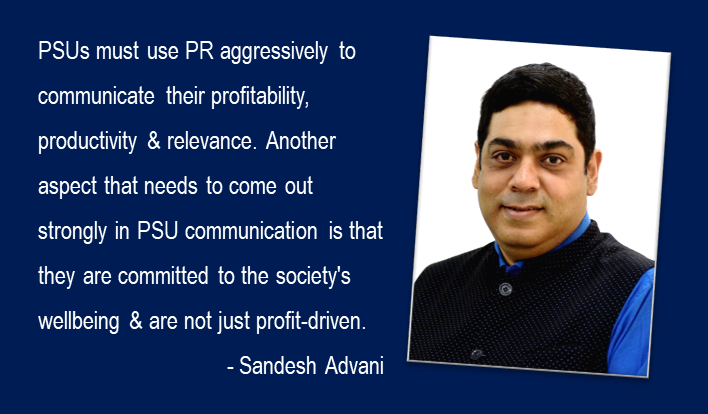Public Relations has a specialised role in a public sector (PSU) communication strategy. Though the PSUs together are essential contributors to a nation’s economic growth, they are often perceived as less efficiently managed than the private sector companies.
The PSUs must use PR aggressively to communicate their profitability, productiveness and relevance to the target publics. However, another aspect that needs to come out strongly in PSU communication is that they are committed to society’s wellbeing and not just profit-driven.
Moreover, PR can help contribute to reviving sick units by bestowing self-reliance in significant sectors of the economy. Some of the other areas where PR can play an essential role in highlighting a PSU’s policies, programmes, achievements, and benefits schemes to influence public opinion.
Other influence areas include:
- Political perception: Combination of PR amidst individual, environmental and organisational influence combine to crystalise an individual’s perception of political or governmental organisations. The emergence of PR in digital platforms also changes how the public views government organisations by enhancing their credibility.
- Public Perception: By increasing PSUs’ visibility in terms of positivity, optimistic views of the organisation add value to public opinion and enhance the organisation’s image.
- Agenda building: Agenda setting for PSUs is the transfer of salience from the media to the public, influencing the importance of a topic. PR assists in making the plan of a PSU clear in the minds of the people.
- Measuring Communication: PR helps PSUs measure their communication effectiveness, giving them the flexibility to develop their policies affecting citizens and stakeholders. Measuring the impact of communication and course-correcting are crucial to the actual implementation, success, and development of various public policies.
- Formulation: Formulating and streamlining adaptive media strategies by PR will go a long way in determining a PSU’s credibility towards stakeholders and citizens.
- Strategy Adoption: The adoption of multifaceted strategies paves the way to reliable and efficient operating methods in a competitive environment.
- Evaluation: Determining how well a PR funnel is working and measuring the effectiveness of the communications on the target audience. Enhancing the understanding of the audience and monitoring the change/intention/impact etc. of the target audience towards the government organisation.
- Implementation of public policy: The communication’s implementation or carrying out is often accomplished by tasks other than those formulated and adopted. A statute usually provides just a broad outline of a policy.
- Assisting the media in coverage of PSU activities: Accurate and proper Coverage of coverage activities, including the negative ones.
- Effective media relations: This is improved by conveying up to date available data and evaluating communication by wisely disseminating communication to the media and keeping the general public updated.
- Increasing the internal cohesion of PSU: Building and ramping up internal cohesion leads to greater efficiency in business communication, which is the forefront of a PSU’s PR cycle.
- Data-driven PR: Data-driven communication has a direct and consequential impact on stakeholders. Analysing many people’s responses to questions can predict trends in news cycles and consumer interests. It can tell you which media articles are gaining traction and those viewed negatively. It can also help you define your audience. PSU campaigns inculcate examining the data for insight and learnings.
- Diverse and multiple levels of accountability: Accountability is the best PR strategy for underlying issues, the weak reputation of the PSUs, and various levels of communications that extends all way from top to bottom of the pyramid of the management.
- Strategy: Strategy is defined based on short, medium and long-term goals and how to accomplish them. Assessing the different media channels, social collaboration platforms, influencers and making an informed decision on the channel to focus on or platform to adopt.
- Policy: Public enlightenment of policy briefing and mandatory know-how about the said PSU.
- Monitoring: Being attentive to activities in media outside the designated owned channels. And effective tracking and guarding the social media platforms for smooth communication.
- Governance: Defining roles and responsibilities communicating them to the right audience through the right channel, and assessing and managing the metrics and quality of the content.
- Crisis management: Executing detailed strategies and tactics to minimise damage to the image of an organisation. The emergency nature of a crisis amid great uncertainty aggravates the already complex decision-making with the urgent need for the management to make decisions rapidly. Also, post-crisis communication is essential in assessing the crisis management effort and providing follow-up crisis messages as needed. The organisation needs to release updates on the recovery process, corrective actions, and investigations of the crisis.
- Setting and measuring PR goals: Setting minimalistic objectives, declaring the value of setting goals and measuring how effectively various projects are implemented towards those goals.
- Quantitative and Qualitative Media measurement: Assessing completeness of data, accuracy including metadata about the source, such as its audience and credibility to its readers.
- Predictive Analytics: With accurate data, PR can deliver insights using predictive analytics, which leverages an assortment of machine learning, algorithms, models, and datasets to predict future behaviour, helping PR teams understand the behaviour of stakeholders and target audience, allowing them to position future campaigns more accurately.
- Active Dialogue: Creating commitment and responsibility within the employees with excellent internal and external dialogues and streamlining communications with the stakeholders & decision-makers, augmenting better results.
- Credibility: The PSU’s credibility is crucial to the stakeholders as there must be cohesion between work and action as PR accentuates timely communication and mitigates crisis and risks.
Managing relationships with key publics in PSUs plays a “strategic” part in communication management “accomplishing” goals and solving complex communication problems. To be considered strategic, communication management must be aligned with the PSU’s vision or mission and substantially contribute to achieving the organisation’s objectives.
The views and opinions published here belong to the author and do not necessarily reflect the views and opinions of the publisher.



Very well written.. Very relevant and an interesting read.. look forward to more articles from you..
Really beneficial information.